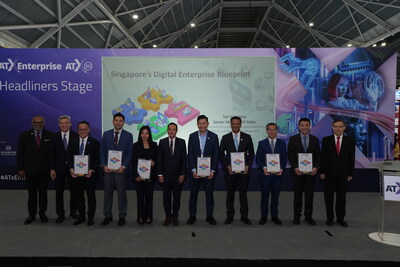Press Release
CGTN: Diffusion of tea and its culture along the Silk Road
[ad_1]
BEIJING, Oct. 15, 2023 /PRNewswire/ — Birol, a local Chinese-language tour guide in Istanbul, Türkiye, considers black tea an indispensable part of his daily routine. Actually, it’s not just Birol. In a typical Turkish household, preparing a cup of black tea using a special tea kettle known as “çaydanlık” is a treasured aspect of everyday life.
Black tea is a constant presence from breakfast to dinner and a customary beverage for welcoming guests and hosting parties, said Briol.
In Türkiye, tea has a rich history spanning over two centuries and has become a vital element of the local culture, deeply ingrained in the daily lives of its people. Today, the country is one of the world’s leading consumers of tea.
This significance has been further highlighted through Türkiye’s participation in the Belt and Road Initiative (BRI). Historically renowned for its strong tea-drinking traditions, it has witnessed the BRI opening doors to increased trade and cultural exchanges.
Besides Türkiye, since China proposed the BRI in 2013, this initiative has played a vital role in mobilizing resources, enhancing connectivity among countries and unlocking potential growth prospects.
Over the past decade, trade and investment have seen consistent growth. From 2013 to 2022, the total value of imports and exports between China and other BRI countries reached $19.1 trillion, maintaining an average annual growth rate of 6.4 percent, according to a white paper released by China’s State Council Information Office on October 10.
By the end of August 2023, more than 80 countries and international organizations had endorsed China’s Initiative on Promoting Unimpeded Trade Cooperation Along the Belt and Road. The country had also signed 21 free trade agreements with 28 countries and regions, further promoting economic cooperation and trade connectivity within the BRI framework.
Thriving global tea market
China’s tea exports witnessed stable growth in 2022. The country exported a total of 375,300 tonnes of tea, marking a 1.59 percent increase compared with that of the previous year, data from the General Administration of Customs shows.
In breakdown, green tea exports amounted to 313,900 tonnes, taking up 83.6 percent of China’s total tea exports. Meanwhile, the exports of black tea and oolong tea constituted 8.9 percent and 5.2 percent, respectively.
BRI-participating countries have also been seeing a surge in their tea exports. Kenya, for instance, exported 1.4 million kilograms of tea to China in 2022, data from the Tea Industry Committee of the China Association for the Promotion of International Agricultural Cooperation shows.
As a prolific tea producer, Kenya yields over 450 million kilograms of tea annually. The tea industry accounts for approximately 23 percent of Kenya’s total foreign exchange earnings, according to the Tea Directorate. The sector also supports the livelihoods of roughly 5 million individuals in Kenya, both directly and indirectly, in a country with a population of 53 million.
This year, Kenya foresees a further boost in its tea export volume due to a growing shipment of Kenyan orthodox and black teas to China, according to the Agriculture and Food Authority of Kenya.
Apart from tea, other trades are also flourishing between the two countries, thanks to the Mombasa-Nairobi Standard Gauge Railway (SGR) that launched in 2017, an early fruit of the BRI. The railway has facilitated the seamless movement of imported bulk cargo to the hinterland, improved logistics and supply chains, and provided a fast, efficient and cost-effective means of transporting bulk cargo.
In the first eight months of 2023, China’s trade in food products, including tea, with BRI countries reached 553.82 billion yuan ($76.10 billion), a 10.4 percent increase compared to the same period last year and a 162 percent increase compared to 2013, official data shows.
In 2022, China’s trade in food products with BRI countries reached 786.31 billion yuan, up 135.3 percent compared to 2013, according to the General Administration of Customs.
As of June this year, China has signed over 200 BRI cooperation agreements with 152 countries and 32 international organizations, expanding the diversity and scale of food trade.
Historical tea roads promote the spread of tea culture
Throughout history, Chinese tea culture has been closely connected to trade expeditions along historic routes like the Tea Horse Road. The route commences in China’s southwestern provinces of Sichuan and Yunnan, meandering along the eastern foothills of the Hengduan Mountains, a center of tea production in China, before extending to India, which is situated to the south of the Himalayas.
Another historical route, the ancient tea road, originated in the Wuyi Mountains in southeast China’s Fujian and spanned approximately 13,000 kilometers. It comprised a web of trading and caravan routes that crisscrossed China to reach Europe, playing a crucial role in spreading Chinese tea to foreign lands.
The ancient tea road was a vital trade route that combined water and land transport to facilitate tea trade, meeting the demands of diverse ethnic communities residing in northwest China, Russia and Europe, according to Huang Baiquan, professor at the School of History and Culture, Hubei University.
This commercial route spans various climates and landscapes, serving as a platform for the harmonious coexistence of diverse economic activities and addressing the livelihood needs of people residing along the route, Huang noted.
The historical trade route aligns closely with the northern route of China’s Silk Road Economic Belt and is an important part of the BRI. It has fostered economic diversity and encouraged multidimensional exchanges of ideas and knowledge between southern and northern China, Russia and Europe.
During the process of tea cultivation and processing, transportation, trade, and consumption, people from diverse nationalities and countries along the ancient tea road have crafted and carried forward a vibrant and diverse tea culture, Huang added.
![]() View original content:https://www.prnewswire.co.uk/news-releases/cgtn-diffusion-of-tea-and-its-culture-along-the-silk-road-301956867.html
View original content:https://www.prnewswire.co.uk/news-releases/cgtn-diffusion-of-tea-and-its-culture-along-the-silk-road-301956867.html

[ad_2]
Source link
Press Release
New Study Reveals Majority of Indians Prioritize Nutrition Over Taste, Surpassing Global Average

[ad_1]
Based on a recent survey of urban Indian consumers:
-
Nine out of 10 consumers are searching for protein-rich food compared to seven out of 10 global shoppers. -
The top four qualities consumers look for when buying snacks are (1) natural, (2) heart-healthy, (3) protein-rich and (4) energy-source, all of which come before satisfying cravings. -
Nuts have emerged as one of the most popular snacking choices, with 86% of Indian shoppers report having purchased them in a span of 6 months. -
Urban Indians read nutrition labels more than the global average, reflecting a growing trend towards informed purchasing. -
69% of urban dwellers surveyed have the opinion that plant-based protein is just as good as meat-based protein, exceeding the global average of 55%.
Wonderful Pistachios, the world’s largest grower and processor of pistachios and distributor of California Pistachios in India, released today, World Nutrition Day, the findings of a new global study that sheds light on the snacking habits of urban Indians. The study, commissioned with Material, a leading global research consultancy, included 10 countries and over 12,400 respondents, revealed a new behavioural trend that urban Indian consumers prioritize nutrition over taste when it comes to snacking. This growing preference for healthy snacking emphasizes the importance of good nutrition for overall well-being.
For the India market specifically, the study delved into the snacking habits of 2,415 shoppers across six Indian cities, which represented a population of approximately 35.9 million consumers. Remarkably, a majority of urban Indians (58%) reported basing their food purchasing decisions on nutritional benefits more than taste, exceeding the global average of 52%. Delhi and Ahmedabad lead with over 60% of urban shoppers preferring nutrition in their food. Bengaluru and Chennai follow closely, indicating a nationwide shift towards smarter snacking preferences. In India, Millennials and Gen Z are leading the charge in health-conscious purchasing decisions, with more than 83% of consumers in these age groups reading nutritional labels before buying.
Indian consumers prioritize four key factors when shopping for nutritional snacks: natural (free of artificial colours and preservatives), heart-healthy, protein-rich, and provides energy. Nine out of 10 urban shoppers consciously seek protein-rich food options, compared to the global average of seven out of 10. The focus on nutrition has fueled the rise of nuts as a preferred snack choice, becoming essential to daily eating habits. The study found a staggering consumption of nuts, with 86% of Indian shoppers report purchasing them in a span of 6 months, compared to just 75% globally. With 6g of protein in per 28g serving, California Pistachios are a smart snack choice that provides benefits without sacrificing taste.
Shail Pancholi, Country Director, India, Wonderful Pistachios, commented on the study, saying, “Nuts were traditionally used as garnishes and consumed during festivals, but have now become a popular snack in India, indicating a notable shift in dietary habits. Pistachio consumption in India has doubled in the last six years, as consumer awareness of the nutritional benefits that pistachios offer has grown. Consumers are discovering that pistachios are naturally cholesterol-free, rich in plant-based protein and dietary fiber, and provide over 30 different vitamins and minerals.”
Interestingly, the study found that nuts are the second most preferred snack among urban Indian consumers, with 64% of Baby Boomers and 59% of Gen Z prioritizing nutrition over taste when selecting food. This indicates a growing focus on health across generations, with Baby Boomers focusing on senior wellness and Gen Z reflecting the rise of mindful purchasing. Though on opposite ends of the age spectrum, these two generations take the lead in seeking protein-rich options, as well as preferring natural snacks.
Mumbai tops most of the consideration sets when choosing a snack. Residents opt for natural ingredients (35% vs. the national average of 30%), heart-healthy options (33% vs. 30%), and protein (33% vs. 29%). Chennai residents look for energy-boosting snacks (31% vs. the national average of 29%).
The fact that 69% of urban Indians surveyed have the opinion that that plant-based protein is just as good as meat-based protein reflects a positive shift towards varied dietary preferences. Pistachios are a good source of high-quality complete protein, containing all nine essential amino acids. A 28g serving of pistachios provides 6g of protein, which is 11% of the recommended daily allowance (RDA) according to FSSAI.
The Wonderful Pistachios study unveils a compelling shift in Indian snacking habits. Nuts are evolving from festive treats to a daily snacking staple, fueled by a nationwide preference for more nutritious options. The trend transcends generations, resonating with Gen Z and Baby Boomers alike, underscoring the growing importance of mindful eating in urban India. As consumers increasingly seek natural, heart-healthy, protein-rich, and energy-boosting snacks, the future of Indian snacking appears to be firmly rooted in nutrition and well-being.
Wonderful Pistachios
Wonderful® Pistachios is the world’s largest grower and processor of pistachios, with a global presence in over 70 countries. As a vertically integrated operation, they are experts in every step of the process from tree to shelf, ensuring the highest-quality product every time. In tandem with its Grower Partners, Wonderful Pistachios harvests 125,000 sunny acres (50,000 hectares) of land in California that receive warm days and cool nights, which work in harmony with the rich, natural soils to create the perfect growing climate for high-quality pistachios. They ship 600 million pounds (204 million kg) of nuts worldwide from their advanced processing facilities to ensure the highest standards are met. When it comes to pistachios, Wonderful® Pistachios expertise is unmatched in scale and capacity, paired with warehouses and sales teams worldwide that are well-equipped to provide support at every step of the way.
California Pistachios
California Pistachios are grown and distributed by The Wonderful Company, the world’s largest vertically integrated pistachio processor and marketer located in California’s Central Valley. California Pistachios are Non-GMO, providing a smart, healthy choice for consumers around the world. Sun-ripened in the moderate Mediterranean climate of California, these distinctively green nuts pack taste and contain antioxidants and over 30 different nutrients. California Pistachios in India are available under leading brands and private labels at retail outlets, grocery stores, and online platforms.
For more information about California Pistachios India, please visit www.b2b.wonderfulpistachios.com
[ad_2]
Source link
Press Release
Singapore Prepares Ahead to Leverage Artificial Intelligence for a Better Future

[ad_1]
SINGAPORE, May 31, 2024 /PRNewswire/ — Senior Minister of State for Communications and Information Tan Kiat How launched the Digital Enterprise Blueprint (DEB) at Asia Tech x Singapore (ATxSG) 2024 today. The Blueprint will enable SMEs to harness technology, optimise the way they work, and strengthen digital resilience and cybersecurity across the ecosystem. 50,000 SMEs are expected to benefit over the next five years through four key focus areas:
- Empower enterprises to be smarter by adopting AI-enabled solutions
- Enable enterprises to scale faster through cloud-based and integrated solutions
- Equip enterprises to be safer through improved cyber resilience
- Support enterprises to upskill workers to make full use of digital capabilities
Seven partners have come onboard to pledge their commitment, including Singapore Business Federation, Singapore Computer Society, SGTech, Amazon Web Services, Google, Microsoft and Salesforce.
In collaboration with IMDA and the TechSkills Accelerator for ITE and Polytechnics Alliance, SGTech is launching the Tech Apprenticeship Programme to expand the career pathways of graduates by providing access to industry apprenticeships that offer on-the-job training and development opportunities. Over the next two and a half years, SGTech aims to facilitate the placement of at least 300 apprentices who are fresh or mid-career professionals from polytechnic or ITE backgrounds, and drive the adoption of similar practices that promote more inclusive hiring and career agility.
IMDA and the Singapore Academy of Law (SAL) signed an MoU aimed at uplifting the legal sector’s productivity through the use of GenAI. As part of this partnership, GPT-Legal, a new large language model which is contextualised for Singapore’s legal sector, will be co-developed. The model will be integrated into SAL’s research platform LawNet, which is accessible by 75% of Singapore’s lawyers. SAL will also be penning an MoU with the National University of Singapore and AI Singapore to develop its AI capabilities and create a certification to recognise AI specialists in the legal profession.
Additionally, Tribe and Digital Industry Singapore announced a collaboration with NVIDIA to launch the Ignition AI Accelerator for AI startups to create and bring to market the next wave of advancement in AI solutions. This programme will nurture 15 high-potential startups, equipping them with well-rounded support covering business and technical needs. NVIDIA and Tribe will also collaborate with EnterpriseSG to offer qualified AI startups funding support through the Startup SG Tech scheme, and assist them through the IMDA Accreditation process.
Singapore hosted the final meeting of the UN Secretary-General’s Artificial Intelligence Advisory Body (AIAB) from 28-29 May. As part of the agenda, Singapore facilitated an engagement session between AIAB and the Digital Forum of Small States (Digital FOSS). Digital FOSS Fellows exchanged views with AIAB members on the topic of AI governance, particularly on the implications and challenges faced by small states. Through such efforts, Singapore aims to promote a more inclusive approach towards shaping global AI and digital governance.
Contact:
[email protected]
![]() View original content to download multimedia:https://www.prnewswire.com/in/news-releases/singapore-prepares-ahead-to-leverage-artificial-intelligence-for-a-better-future-302160193.html
View original content to download multimedia:https://www.prnewswire.com/in/news-releases/singapore-prepares-ahead-to-leverage-artificial-intelligence-for-a-better-future-302160193.html

[ad_2]
Source link
Press Release
One in Six Globally Concerned About Colorectal Cancer Screening Costs

[ad_1]
SHENZHEN, China, May 31, 2024 /PRNewswire/ — By 2040, the burden of colorectal cancer (CRC) is projected to increase to 3.2 million new cases and 1.6 million deaths per year representing a 66% and 71% rise in new cases and deaths respectively relative to 2020.

To better address the global burden of CRC and reduce its impact, BGI Genomics has launched the second edition of its global CRC awareness report, covering 1,938 respondents from Brazil (306), China (367), Poland (300), Saudi Arabia (300), Thailand (362), and Uruguay (303):
CRC Screening Gaps Vary Globally: Nearly half (49.3%) of global respondents have never undergone CRC screening, with the highest proportions in Saudi Arabia (62.0%) and Poland (61.0%).
Preference for Fecal Testing Over Colonoscopy: Although colonoscopies are more recognized (33.4%), fecal tests at healthcare facilities are preferred (31.8%), reflecting a trend towards non-invasive methods.
Cost and Fear are Determinants of Screening Choice: Fear of colonoscopy (18.2%) and screening costs (17.7%) are major barriers to CRC screening. Poland (24.7%) and Uruguay (21.0%) show the highest fear of colonoscopy, while Thailand (24.5%) and Brazil (20%) indicate the most concern about costs.
Medical Advice and Family History Drive CRC Screening: Doctor’s recommendations are a major driver for CRC screening (30.5% globally), with Uruguay showing the highest adherence (44.1%). Additionally, those with a family history of CRC are more proactive in screening (64.5%), compared to the general population (35.0%).
Prof. Varut Lohsiriwat from Mahidol University offers his insights to this report. He suggested: “The essence of effective cancer screening lies in the acceptance and adherence of the patient to the screening method. The best screening method is the one that the patient accepts and adheres to because that’s the method that will actually benefit them.”
Dr. Zhu Shida, BGI Genomics Deputy GM, notes: “At BGI Genomics, we focused our efforts on developing advanced molecular biology testing techniques to close the gap [between acceptance and accessibility]. The ultimate goal is to transform colorectal cancer from a life-threatening disease into a manageable condition through widespread, early screening and intervention.”
For more region-level comparisons, access the full BGI Genomics 2024 State of CRC Awareness Report.
All data involved in this report come from the results of an online survey project conducted by BGI Genomics. It only surveys awareness related to colorectal cancer and does not involve personally identifiable data.
Logo – https://mma.prnewswire.com/media/1608027/BGI_Logo.jpg
![]() View original content:https://www.prnewswire.co.uk/news-releases/one-in-six-globally-concerned-about-colorectal-cancer-screening-costs-302159170.html
View original content:https://www.prnewswire.co.uk/news-releases/one-in-six-globally-concerned-about-colorectal-cancer-screening-costs-302159170.html

[ad_2]
Source link

 Fashion8 years ago
Fashion8 years agoThese ’90s fashion trends are making a comeback in 2017

 Entertainment8 years ago
Entertainment8 years agoThe final 6 ‘Game of Thrones’ episodes might feel like a full season

 Fashion8 years ago
Fashion8 years agoAccording to Dior Couture, this taboo fashion accessory is back

 Entertainment8 years ago
Entertainment8 years agoThe old and New Edition cast comes together to perform

 Sports8 years ago
Sports8 years agoPhillies’ Aaron Altherr makes mind-boggling barehanded play

 Press Release8 years ago
Press Release8 years agoUber and Lyft are finally available in all of New York State

 Sports8 years ago
Sports8 years agoSteph Curry finally got the contract he deserves from the Warriors

 Entertainment8 years ago
Entertainment8 years agoDisney’s live-action Aladdin finally finds its stars





